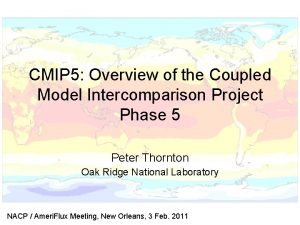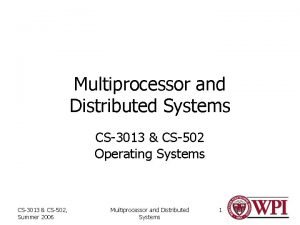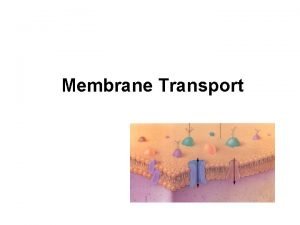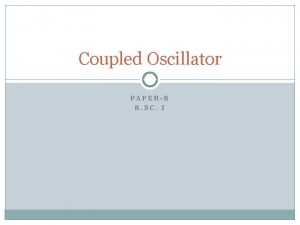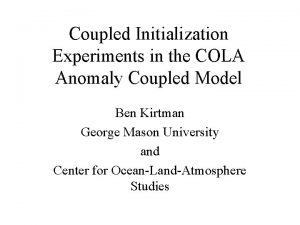The sensitivity of a coupled climate model to






- Slides: 6

The sensitivity of a coupled climate model to its ocean component Alex Megann National Oceanography Centre Southampton SO 15 2 RZ UK • Had. CM 3 is a world-leading coupled climate model developed by the Hadley Centre. Widely studied, and used in IPCC AR 3 and AR 4. • CHIME is derived from Had. CM 3 by replacing the Cox-Bryan z-coordinate ocean component of Had. CM 3 with a hybrid model (HYCOM v 2. 1. 34). • CHIME ocean has same horizontal resolution as Had. CM 3 (1. 25°) south of 55°N; a bipolar patch in Arctic; and 25 layers. • Ice model and atmosphere same as in Had. CM 3.

SST errors in CHIME and Hadley Centre models CHIME Had. CM 3 • CHIME has a warm bias at the surface (in Southern Ocean much of this can be related to errors in KPP scheme), • Hadley Centre family of models (including Had. CM 3, Had. GEM and Hi. GEM) tend to have a cold surface bias. Had. GEM 1

Global temperature drifts in CHIME and Had. CM 3 models CHIME • CHIME warms in the upper 500 metres and cools between 500 and 2, 000 metres. • Had. CM 3 globally warms in upper 1, 000 metres (but, when the Southern Ocean is disregarded, cools in the upper ocean). • Salinity drifts are similar: CHIME becomes saltier in upper 300 metres, fresher below, while Had. CM 3 becomes progressively fresher in upper ocean. Had. CM 3 Global temperature drifts from initial state

Subtropical region temperature drift CHIME • When polar, subpolar and equatorial regions are excluded, tendencies in CHIME and Had. CM 3 are similar but opposite: warming above 400 metres and cooling between 500 m and 2, 000 m in CHIME, and vice versa in Had. CM 3. • Consistent with hypothesis that HYCOM is not diffusive enough in subtropical thermocline regions, while Had. CM 3 level ocean is too diffusive. Had. CM 3 Temperature drifts from initial state, 10°N-50°N, 10°S-50°S

N Atlantic subtropical thermocline diffusion CHIME • Enhanced diffusion in N. Atlantic subtropical thermocline in Had. CM 3 is clear. • CHIME perhaps under-diffusive. • Effects on embedded biogeochemical models? Had. CM 3 Annual mean temperature in N. Atlantic, 10°N – 50°N

Summary • CHIME has warm surface bias, where Had. CM 3 (and other Hadley Centre models) are too cold. • CHIME also has salty surface bias, where Had. CM 3 freshens. • These tendencies occur mainly in the subtropical regions, and are consistent with excessive diapycnal diffusion across thermocline in Had. CM 3 (and possibly not enough in CHIME). Also: • NADW is better represented in CHIME, having a more realistic depth (less mixing of sill overflow water). • SAMW and AAIW are better preserved in CHIME: in Had. CM 3 these are diffused away in first decade or two. But: • CHIME has warm and salty error in N. Atlantic subpolar gyre (related to error in NAC path and possibly to excessively low wind stress in atmosphere model).

